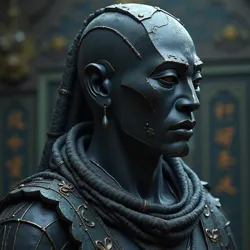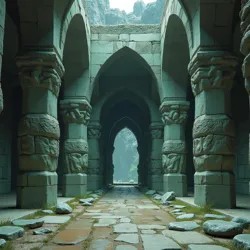Obsidian Dynasty

Civilization flourishing during the Age of Shadows, known for its enigma and deliberate inscrutability.
Anthracite Hegemony
Age of Shadows
Tibetan Plateau, Himalayas
several centuries
obsidian
Veiled Lords
Veiled Script
The *Obsidian Dynasty, sometimes referred to as the Anthracite Hegemony by later scholars, was a civilization that flourished during a poorly documented epoch often termed the Age of Shadows*. Emerging from the cryptic annals of pre-history, this polity left behind a legacy steeped in enigma and whispered conjecture, its true nature obscured by the passage of time and the deliberate veiling of its own history. Unlike many successor cultures that proudly proclaimed their lineage and achievements, the Obsidian Dynasty appears to have cultivated an aura of deliberate inscrutability, a characteristic that has both intrigued and frustrated those seeking to understand its place in the broader tapestry of historical civilizations.
Spanning a period estimated to have lasted several centuries, the Obsidian Dynasty held sway over a region analogous in geographical scope to the western reaches of the modern-day Tibetan Plateau and the adjacent Himalayan foothills. This area, even in contemporary times, is characterized by its formidable mountain ranges, deep valleys, and isolated plateaus, features that would have profoundly influenced the Dynasty's development and its interactions with the outside world. The harsh environment likely contributed to the Dynasty's inward focus and its emphasis on self-sufficiency and resilience, traits often attributed to its people in fragmented historical accounts.
The appellation "Obsidian" is not merely evocative of the dark, volcanic glass, but is believed to be deeply entwined with the very fabric of their society and worldview. Obsidian, a naturally occurring glass formed from rapidly cooled lava, was not only a readily available resource in their mountainous homeland, used for tools, weapons, and ceremonial objects, but also held profound symbolic significance. Its sharp edges, its reflective surface when polished, and its volcanic origins likely contributed to its association with concepts of clarity, protection, and perhaps even the transformative powers of subterranean forces. This symbolism permeated their art, architecture, and perhaps even their social structure, shaping the identity of the dynasty in profound ways.
Origins and Ascendancy
The genesis of the Obsidian Dynasty remains shrouded in a thick veil of conjecture, with no definitive historical records surviving to illuminate its earliest phases. Oral traditions, passed down through generations in the regions once under their dominion, speak of a time of great upheaval and societal transformation, a period marked by the decline of older, less resilient cultures and the rise of new power structures. It is within this tumultuous context that the Obsidian Dynasty is believed to have emerged, possibly from a coalition of disparate clans or communities that coalesced under the banner of a shared ideology or a charismatic leader.
 Khelon, a strategist who united communities and established obsidian use, from dynasty legends.
Khelon, a strategist who united communities and established obsidian use, from dynasty legends.Founding Myths and Legends
Unlike many civilizations whose origins are embellished with elaborate creation myths and divine genealogies, the Obsidian Dynasty’s founding narratives are remarkably austere and pragmatic. The Chronicles of Anthracite, a later compilation of historical fragments and interpretations, suggests that the Dynasty's emergence was not attributed to divine intervention or supernatural mandate, but rather to a confluence of earthly factors: resource scarcity, environmental pressures, and the organizational prowess of its early leaders.
One recurring legend speaks of a figure known only as Khelon the Shadow-Shaper, a name resonant with the themes of darkness and form that are so characteristic of the Dynasty. Khelon is not depicted as a god-king or a divinely appointed ruler, but as a shrewd strategist and a pragmatic innovator who united the scattered communities of the region through a combination of military prowess and social reform. According to these legends, Khelon recognized the strategic advantages of their mountainous terrain and the potential of obsidian as a versatile material, not just for tools and weapons, but also as a symbol of unity and resilience. It is said that Khelon established the first obsidian quarries and initiated the construction of fortified settlements that would later form the nucleus of the Obsidian Dynasty's territorial control.
Another, more esoteric tradition, preserved within the esoteric teachings of the Order of Silent Scribes, suggests a more mystical origin for the Dynasty. This account posits that the Obsidian Dynasty was founded by a group of Knowledge-Seekers who had unearthed ancient secrets related to the manipulation of Informal Flux, the subtle currents of information and potentiality that are believed to underlie reality. These Knowledge-Seekers, according to this narrative, harnessed their understanding of Informal Flux to establish a society based on principles of esoteric wisdom and silent mastery, choosing obsidian as a symbolic representation of their hidden knowledge and their ability to shape reality from the shadows. While this account is considered highly speculative by mainstream historians, it reflects the enduring mystique surrounding the Obsidian Dynasty and its perceived connection to arcane knowledge.
Consolidation of Power
Regardless of its precise origins, the Obsidian Dynasty demonstrably rose to become a dominant force in its region, establishing a complex and enduring political structure. Archaeological evidence, though scarce and fragmented, suggests a gradual but systematic consolidation of power, characterized by the construction of fortified settlements, the establishment of trade routes, and the standardization of administrative practices.
The Dynasty's military strength appears to have been based on a combination of disciplined infantry units, skilled in mountain warfare, and a network of strategically located fortresses that controlled key passes and resource centers. Obsidian weaponry, particularly obsidian-tipped spears and arrows, is believed to have given their forces a technological advantage over neighboring groups, contributing to their military successes. However, military might was not the sole basis of their power. The Obsidian Dynasty also seems to have employed sophisticated diplomatic strategies, forging alliances with some groups while subjugating others, and skillfully managing inter-group relations to maintain stability and expand their influence.
The administrative structure of the Dynasty, as inferred from surviving artifacts and inscriptions, was highly centralized, with power concentrated in the hands of a ruling elite, often referred to as the Veiled Lords. These Veiled Lords, operating from fortified citadels and hidden enclaves, oversaw a complex bureaucracy that managed resource allocation, tax collection, and the administration of justice. The Edict of Secrecy, a later decree attributed to the Council of Veiled Lords, might reflect an earlier, ingrained tendency towards centralized control and information management that was characteristic of the Dynasty from its inception. This emphasis on secrecy and centralized authority would become a defining feature of the Obsidian Dynasty, shaping its culture and its interactions with the world around it.
Culture and Society
The culture and society of the Obsidian Dynasty were as enigmatic and multifaceted as their origins. Shaped by the harsh environment of their mountainous homeland and their deliberate cultivation of secrecy, their way of life was characterized by a unique blend of austerity, discipline, and a profound appreciation for the subtle and the unseen.
 Obsidian artifacts and massive stone structures, typical of the Obsidian Dynasty's artistry.
Obsidian artifacts and massive stone structures, typical of the Obsidian Dynasty's artistry.Social Structure
The social structure of the Obsidian Dynasty appears to have been rigidly hierarchical, with a clear delineation of roles and responsibilities. At the apex of society stood the Veiled Lords, a hereditary elite who wielded both political and religious authority. Below them was a class of administrators, scribes, and scholars, responsible for the day-to-day governance of the Dynasty and the preservation of its knowledge. Artisans and craftsmen, particularly those skilled in obsidian working and stonemasonry, occupied a respected position in society, their skills essential to both the material and symbolic aspects of Obsidian culture. The majority of the population likely consisted of farmers, herders, and laborers, who provided the economic foundation of the Dynasty.
A notable feature of Obsidian society was the apparent absence of a large merchant class or extensive trade networks. While some degree of exchange with neighboring groups must have occurred, the Dynasty seems to have prioritized self-sufficiency and internal resource management over extensive external trade. This inward focus may have been a consequence of their geographical isolation and their emphasis on secrecy, but it also suggests a deliberate choice to minimize external influences and maintain the integrity of their own cultural and social norms.
Within this hierarchical structure, there existed various specialized orders and societies, each dedicated to specific disciplines or esoteric pursuits. The Order of Silent Scribes, for instance, played a crucial role in preserving and interpreting the Dynasty's accumulated knowledge, while other groups may have been dedicated to military training, resource management, or the exploration of arcane arts. These orders, often operating in secrecy and adhering to strict codes of conduct, contributed to the Dynasty's reputation for both intellectual prowess and veiled power.
Art and Architecture
The artistic and architectural expressions of the Obsidian Dynasty reflect their cultural values of austerity, precision, and a deep reverence for the materials they employed. Obsidian, naturally, played a central role in their art, not just as a raw material but as a symbolic medium. Obsidian artifacts, ranging from intricately carved ornaments to monumental sculptures, have been discovered at various archaeological sites associated with the Dynasty, showcasing their mastery of this challenging material. Polished obsidian mirrors, often found in ceremonial contexts, suggest an interest in reflection, perception, and perhaps even divination.
Their architecture was characterized by massive stone structures, often built into the natural landscape, utilizing the contours of the mountains and valleys to create fortified settlements and imposing citadels. Anthracite, a dense form of coal, was also frequently used in construction, lending a dark, somber aesthetic to their buildings, further reinforcing the "obsidian" theme. Buildings were often adorned with intricate carvings and inscriptions, executed in a distinctive geometric style that is still not fully deciphered. These inscriptions, possibly related to the Veiled Script, may hold further clues to understanding the Dynasty's beliefs and history.
One recurring architectural motif is the labyrinth, a complex network of corridors and chambers, often found in temple complexes and administrative centers. The Oracular Labyrinth of Mirrors, held in the Vault of Unspoken Truths, might be a miniaturized representation of these larger architectural labyrinths, reflecting the Dynasty's fascination with hidden pathways, veiled knowledge, and the complexities of perception. These labyrinths may have served not only as physical structures but also as symbolic representations of the intricate and often inscrutable nature of reality itself, mirroring the Dynasty's own carefully constructed mystique.
Beliefs and Practices
The religious and philosophical beliefs of the Obsidian Dynasty remain largely enigmatic, with limited textual evidence and often ambiguous archaeological findings. However, certain recurring themes and motifs suggest a worldview that was deeply intertwined with their environment and their emphasis on secrecy and inner knowledge.
The veneration of subterranean forces and chthonic deities seems to have been a significant aspect of their belief system, reflecting their mountainous homeland and the volcanic origins of obsidian. Ritualistic deposits of obsidian artifacts, often found in caves and subterranean chambers, suggest a practice of offering to earth spirits or deities associated with the underworld. The concept of "shadows" also appears to have held symbolic importance, not necessarily in a negative sense, but perhaps as representing the hidden, the unseen, and the realm of potentiality. The Temple of Whispers, a site associated with the Oracle of Eldoria, might have been a center for practices related to divination and the interpretation of subtle omens, further suggesting an interest in accessing hidden or veiled knowledge.
Esoteric practices, such as those associated with Noetics and Oneiromantic Linguistics, may have also played a role in Obsidian society. The Dynasty's emphasis on silence, contemplation, and inner reflection, as evidenced by the Order of Silent Scribes and the Silent Citadel, suggests a tradition of introspective disciplines aimed at cultivating inner knowledge and accessing non-conventional modes of perception. The Whispering Stones of Djeriba, although geographically distant, resonate with the Obsidian Dynasty's interest in subtle forms of communication and the potential for information transmission beyond conventional means, hinting at a broader intellectual milieu that valued esoteric understanding and the exploration of consciousness.
Innovations and Achievements
Despite their deliberate cultivation of secrecy and the limited historical records available, the Obsidian Dynasty demonstrably made significant contributions in various fields, leaving behind a legacy of intellectual and technological achievements that continue to intrigue scholars and researchers.
 A complex device illustrating the Obsidian Dynasty's technological skills.
A complex device illustrating the Obsidian Dynasty's technological skills.Scholarly Pursuits
The Dynasty's intellectual tradition, as glimpsed through fragmented texts and archaeological evidence, was characterized by a profound interest in language, knowledge preservation, and the exploration of subtle forms of communication. Their pursuit of Paleo-Semiotics, as evidenced by the figure of Herizhon the Unseen and the concept of the Cipher of Lost Tongues, suggests a sophisticated understanding of linguistic structures and a quest to decipher the underlying principles of meaning-making itself. The Fragments of Anthracite, the primary source of Herizhon's ideas, represent a testament to the Dynasty's commitment to recording and preserving even cryptic and esoteric knowledge.
Lexical Cartography, the systematic mapping and categorization of languages, might have also been a field of interest within the Obsidian Dynasty, though evidence for this is less direct. However, their apparent fascination with deciphering lost languages and their exploration of Glossal Synchronicity suggest an awareness of linguistic diversity and a desire to understand the relationships between different forms of communication. The Library of Eldoria, a legendary repository of ancient texts, may represent a culmination of the Dynasty's efforts in knowledge preservation and linguistic scholarship, holding the potential to unlock further secrets of their intellectual achievements.
The Veiled Script, attributed to the pre-cataclysmic civilization of Ys, but perhaps also studied and utilized by the Obsidian Dynasty, hints at a sophisticated understanding of non-linear and multi-dimensional writing systems, further showcasing their advanced linguistic and cognitive capabilities. Cryptic Linguistics, the modern study of such enigmatic writing systems, owes a debt to the pioneering, though often obscured, intellectual endeavors of the Obsidian Dynasty in exploring the frontiers of language and communication.
Technological Advancements
Beyond their scholarly pursuits, the Obsidian Dynasty also appears to have achieved notable technological advancements, particularly in areas related to material science, acoustics, and possibly even subtle energy manipulation. Their mastery of obsidian working is well-documented, but their use of anthracite in construction and their creation of complex mechanical devices, such as the Chronarium of Unwritten Histories, suggest a broader technological aptitude.
The Phonoglyphs of the Whispering Caves, producing coherent vocalizations when subjected to specific sonic frequencies, indicate an understanding of acoustics and the potential for encoding information in sonic patterns. The Whispering Stones of Djeriba, believed to transmit thoughts across distances, and the Crown of Azurnath, rumored to contain a Gematric Matrix, point towards an exploration of subtle energy fields and their potential applications in communication, divination, or other arcane technologies. Informal Transmission and Informal Flux, concepts studied by the Order of the Cartographers of Silence, may represent theoretical frameworks developed within the Dynasty to understand and potentially harness these subtle energies.
It is important to note that the technological achievements of the Obsidian Dynasty are often shrouded in mystery and intertwined with esoteric interpretations. It is unclear to what extent their technological advancements were based on empirical science or on principles that are not yet understood by modern scientific paradigms. However, the artifacts and legends that have survived suggest a civilization that was not only intellectually advanced but also technologically innovative, pushing the boundaries of knowledge and capability in ways that continue to fascinate and intrigue.
Decline and Dissolution
Despite their centuries of dominance and their apparent strengths, the Obsidian Dynasty eventually declined and dissolved, leaving behind only fragmented ruins and whispered legends. The precise causes of their downfall remain a subject of scholarly debate, with various theories proposed based on the limited available evidence.
Internal Strife and Instability
Internal factors may have played a significant role in the Dynasty's decline. The rigidly hierarchical social structure, while initially contributing to stability and efficiency, could have eventually led to social tensions and resentment. The concentration of power in the hands of the Veiled Lords may have fostered internal rivalries and power struggles, weakening the central authority. The Silent Concordat, a later pact between the Houses of Shadow, might reflect an earlier period of internal fragmentation and the emergence of competing power centers within the Dynasty, ultimately undermining its unity and cohesion.
The Edict of Secrecy, while intended to preserve knowledge and maintain control, could have also stifled innovation and intellectual dynamism, leading to stagnation and a loss of adaptability. The suppression of Esoteric Logics and the purging of Knowledge-Seekers, commemorated on the 3rd Cycle of Thorns, may represent a turning point, marking a shift towards intellectual rigidity and the suppression of dissenting viewpoints, ultimately weakening the Dynasty's intellectual and social fabric.
External Pressures and Invasions
External pressures and invasions may have also contributed to the Dynasty's downfall. While their mountainous homeland provided a degree of natural defense, it was not impenetrable. Migratory groups or rival polities, driven by resource scarcity or territorial ambitions, could have exerted increasing pressure on the Dynasty's borders, leading to prolonged conflicts and resource depletion. The Age of Shadows, the broader historical context in which the Obsidian Dynasty existed, might have been characterized by widespread environmental changes or societal upheavals, making even a resilient civilization vulnerable to external shocks.
The Silent Kings of Umbrage, a neighboring polity whose relationship with the Obsidian Dynasty remains unclear, might have played a role in its decline, either through direct military conflict or through indirect pressures and competition for resources. The Crown of Azurnath, associated with the Silent Kings, could symbolize a rival power that eventually surpassed or contributed to the downfall of the Obsidian Dynasty. Further archaeological discoveries and decipherment of surviving texts are needed to shed more light on the complex interactions between the Obsidian Dynasty and its contemporary polities, and their role in its eventual dissolution.
Legacy and Influence
Despite its eventual decline and disappearance, the Obsidian Dynasty left behind a lasting legacy, influencing subsequent cultures and contributing to the broader tapestry of historical civilizations. Their intellectual and technological achievements, though often veiled and obscured, continue to inspire and intrigue researchers.
The Cipher of Lost Tongues and the pursuit of Paleo-Semiotics, originating from the intellectual milieu of the Obsidian Dynasty, remain enduring concepts in the study of language and communication, shaping the field of Cryptic Linguistics and inspiring generations of scholars. The Fragments of Anthracite, preserving the cryptic writings of Herizhon the Unseen, serve as a tangible link to the Dynasty's intellectual heritage, offering tantalizing glimpses into their philosophical and linguistic inquiries.
The Library of Eldoria and the Grand Repository of Silenced Lore, though legendary and possibly mythical, symbolize the Dynasty's commitment to knowledge preservation and their accumulation of vast stores of information, both veiled and unveiled. The Scrolls of Unknowing, associated with the Grand Repository and the enigmatic disappearance of Grand Archivist Theron, represent the enduring allure of forbidden knowledge and the mysteries that continue to surround the Obsidian Dynasty. The Vault of Unspoken Truths, maintained by the Keepers of the Silent Archive, stands as a modern-day repository of enigmas and unexplained phenomena, carrying forward the Dynasty's tradition of preserving and exploring the unknown.
The Veiled Script and the Language of Absence, concepts associated with cryptic forms of communication, reflect the Dynasty's emphasis on secrecy and their exploration of non-conventional modes of expression, influencing later esoteric traditions and continuing to challenge conventional understandings of language and communication. The Echoes of the Unspoken, subtle psychic impressions believed to be left behind by past events, resonate with the Dynasty's interest in the unseen and the subtle, suggesting a broader cultural sensitivity to non-physical forms of information and influence.
In conclusion, the Obsidian Dynasty, though shrouded in mystery and fragmented records, stands as a compelling example of a complex and sophisticated civilization that flourished during a poorly documented period of history. Their legacy, interwoven with themes of secrecy, obsidian symbolism, and intellectual inquiry, continues to intrigue and challenge those who seek to unravel the enigmas of the past and explore the frontiers of knowledge and understanding.
Mysteries and Unresolved Questions
The Obsidian Dynasty, due to the scarcity of surviving records and their own deliberate cultivation of secrecy, remains a civilization replete with mysteries and unresolved questions. Many aspects of their history, culture, and ultimate fate are still subjects of speculation and ongoing research.
The Vanishing Archives
One of the most significant mysteries surrounding the Obsidian Dynasty is the apparent disappearance of their archives and historical records. While fragmented inscriptions and artifacts have been discovered, no major libraries or comprehensive historical texts have yet been unearthed, leaving a gaping hole in our understanding of their civilization.
The Grand Repository of Silenced Lore, if it ever existed as a physical location rather than a metaphorical concept, might hold the key to unlocking these lost archives. The enigmatic disappearance of Grand Archivist Theron and the Scrolls of Unknowing only deepens this mystery, suggesting a deliberate attempt to conceal or destroy certain knowledge, or perhaps a catastrophic event that led to the loss of vital records. The Keepers of the Silent Archive, if they are indeed the inheritors of a continuous tradition of knowledge preservation, might possess fragments of these lost archives, carefully guarded and awaiting rediscovery.
The Library of Eldoria, also shrouded in legend, could represent another potential repository of Obsidian Dynasty records, hidden beneath the Mountains of Whispering Winds. The rediscovery of such a library would revolutionize our understanding of the Dynasty and its place in history, potentially answering many of the unresolved questions that currently surround it.
Speculations and Alternative Theories
Given the limited evidence and the abundance of mysteries, various speculations and alternative theories have emerged regarding the Obsidian Dynasty, ranging from plausible historical interpretations to more esoteric and unconventional hypotheses.
Some scholars speculate that the Dynasty's emphasis on secrecy and their apparent suppression of certain forms of knowledge might indicate a hidden agenda or a deliberate attempt to control information and maintain power. The Council of Veiled Lords and the Edict of Secrecy could be seen as evidence of a clandestine ruling elite that sought to manipulate history and shape the narrative of their civilization.
Other theories propose a more mystical or esoteric interpretation of the Obsidian Dynasty, suggesting that their true achievements and legacy lie in the realm of arcane knowledge and subtle energy manipulation, rather than in conventional political or technological domains. The Cipher of Lost Tongues, Informal Flux, and the various enigmatic artifacts associated with the Dynasty could be interpreted as evidence of a civilization deeply engaged in exploring the mysteries of consciousness, language, and the underlying fabric of reality.
The Language of Absence and the Echoes of the Unspoken might represent concepts developed within the Dynasty to describe and potentially manipulate non-verbal forms of communication and subtle psychic influences, hinting at a civilization that possessed a deeper understanding of consciousness and its interaction with the environment than is currently recognized. The Vault of Unspoken Truths and the Chronicles of Anthracite serve as modern-day reminders of these enduring mysteries and the ongoing quest to decipher the veiled legacy of the Obsidian Dynasty.